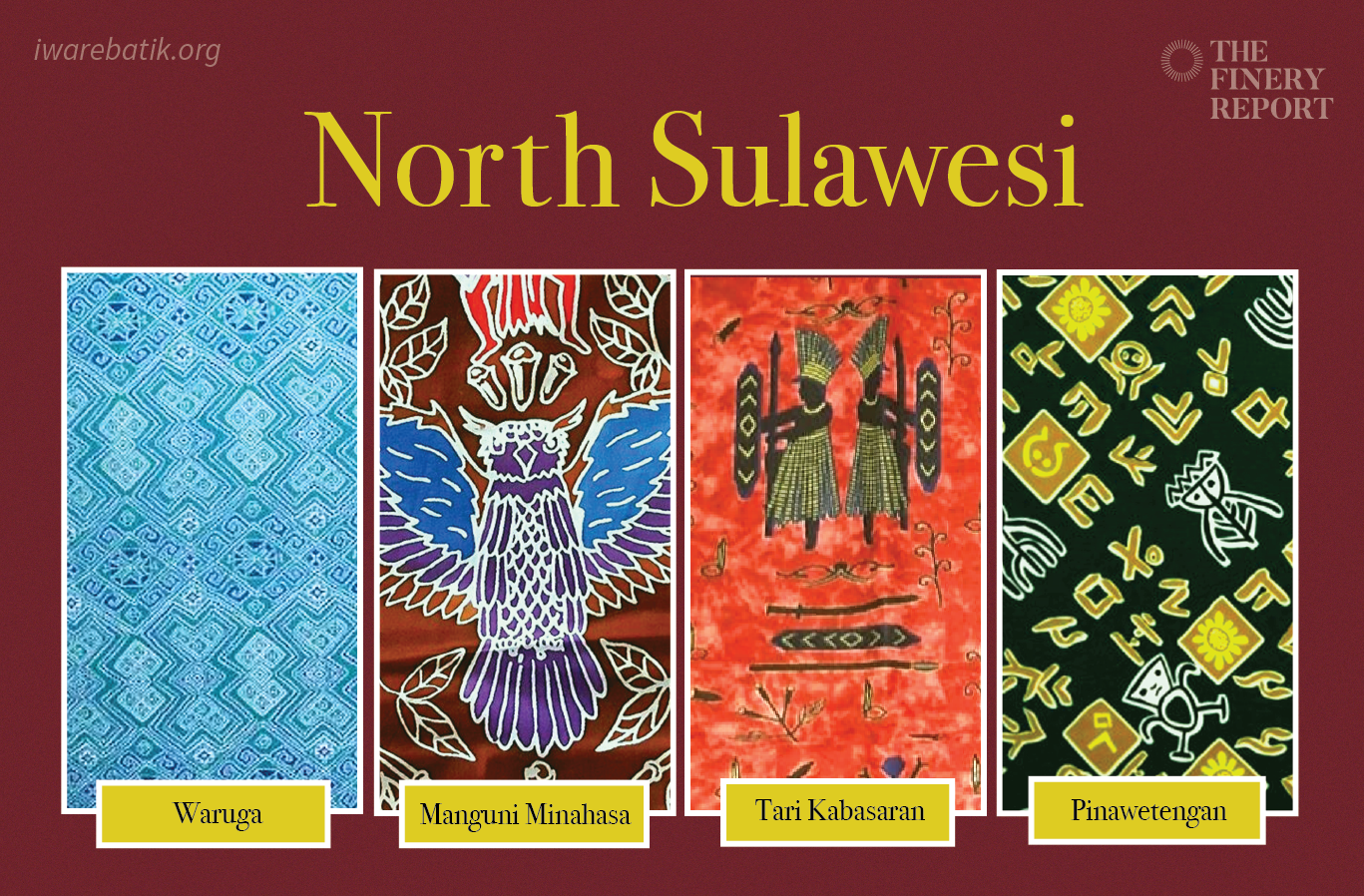Tracing batik in Sulawesi
Read in Indonesian
In order to learn more about the history and the motifs of Indonesian batik, TFR reached out to Sobat Budaya, one of the contributors of iWareBatik, a web-based application that is dedicated to record the history of Indonesian batik.
In the production stage, a piece of batik could take a very long time to finish, between one month and up to two years. Generally, the textile goes through six to eight steps. There are two ways for an artisan to create the patterns they want: first is nglereng or to handwrite the motif using canting, the waxing tool, on the linen. The second is ngecap or stamping the wax pattern on the linen.
The next step is nyelup or dipping the textile into a barrel of natural dye or dyeing solution. This step may take days or months depending on the complexity of the design. Next is nembok or covering the desired parts using canting with a bigger spout before the fabric go through the next dyeing process.
The fourth step is nyolet, a dyeing process using brush for more detailed designs, followed by nglorod or the wax-removing process that requires washing the textile in hot water mixed with sodium carbonate solution. This process can take two to three days, depending on the thickness of the wax.
Some artisans also applied finishing touches, such as fiksasi, or locking the colours using a solution made of pine tree sap called gondorukem, and mordanting, or improving the colour durability by mixing Turkey Red Oil in the soaking water. The last phase is njemur, or hanging the cloth to dry.
Each batik design that exists out there is the reflection of the surrounding community and culture of the artisans. This is what makes batik throughout the Indonesian archipelago look different from one area to another. In this article, let’s take a peek at how batik looks in Sulawesi.
Gorontalo
Since the 16th century, the Gorontalo community has developed their own textile called the karawo embroidery. In the 17th-18th century, the colonials destroyed many of the local traditions. However, the women group in the community protected the karawo embroidery by inheriting the technique through generations. Today, the Gorontalo community combined the karawo patterns and the batik technique to create their own batik.
Batik was first popularised in 2010 by local artist Arfa Hamid. The motifs are inspired by the agrarian society of Gorontalo and reflect their harmonious society. The Gorontalo people have their own philosophy in the colours. For them, red symbolises courage and responsibility, green is the colour for prosperity, fertility and peace, golden yellow signifies loyalty and honesty, while purple represents authority.
Some of the notable motifs from Gorontalo are jagung, karawo pinang, teluk tomini and karawo mahkuta.
Central Sulawesi
Palu has developed its own textile tradition namely the bomba weaving technique; i.e. weaving silk thread using traditional looms into a fabric. Today, they also produce batik textile bearing the bomba motifs using natural dyes, namely bomba batik.
The motifs of bomba batik reflect the open-mindedness and high tolerance to differences of the Palu people. They also develop a number of motifs depicting the values of the local culture, such as sambulugana (areca nut and betel leaf), souraja (traditional house), taiganja (valuable metal ornaments) and maleo bird. Other notable motifs are sero tangga, bomba mawar and cengkeh.
North Sulawesi
Minahasa regency is known for its textile traditions, both the weaving and the batik. Minahasan batik adopts the ancient letters and other ethnical motifs which illustrate the people’s cultural values and traditions.
One of the most famous motifs is waruga, which illustrates the Minahasan above ground tombs as a reminder for Minahasan people of their ancestors. Other notable motifs from this area are pinawetengan, tari kabasaran and manguni minahasa.
South Sulawesi
In South Sulawesi, there are two motif groups: the Torajan and Bugis. Batik with these two motif groups are crafted using the same techniques as Javanese batik. The Torajan people are known to have been developing batik even before Christ as its batik is the earliest batik discovery in the Indonesian archipelago. In other words, the craftsmanship of Toraja batik is not influenced by the Indian batik technique like batik in other Indonesian areas.
The motifs of Torajan batik usually use gentler colours with meaningful themes, such as pateddong which symbolises greatness, glory and prosperity. Meanwhile, Bugis batik is usually brighter and bolder in colours. The motifs represent the life of the coastal society in South Sulawesi and showcase the ancient Lontara letters and La Galigo design. Other notable motifs of this area are paqbarre allo and tongkonan.
Southeast Sulawesi
Motifs of Southeast Sulawesi batik are based on the pattern of their tolaki woven textile. This textile tradition is called tolaki batik and it has three main motifs, namely kalo sara, jonga bertanduk lima and sago tree. They also weave golden threads into the fabric.
There is local wisdom embedded in each motif. The kalo sara motif represents the customary law that has to be upheld by the Tolaki society. Jonga bertanduk lima represents the local custom of deer-hunting. The sago tree motif illustrates the staple food of the community. Other notable motifs are ake patra, pati pati pinehiku and wakatobi.
West Sulawesi
West Sulawesi batik, or commonly known as mandar batik, represents the local maritime community. The motifs illustrate local sea creatures, such as arowana, and fish gills. Many of the themes they showcase in their batik have become the cultural icon of the Mandarese and West Sulawesi society.
The highlights of mandar batik is the use of various colours to represent the social dynamics of the West Sulawesi people. The colours they usually incorporate in their designs include blue, red, purple, yellow, green, turquoise and black. Some of the notable motifs are sandeq, sekomandi, rumah mamuju and lipaq sabe.
Learn about the history, cultural implications, the meaning behind every motif, and so much more about Indonesian batik at www.iWareBatik.org



















